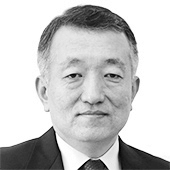Where is the president on pension reform?

Koh Hyun-kohn
The author is the executive editor of the JoongAng Ilbo.
The Yoon Suk Yeol government has failed in the area of pension reform. It has made little strides, and the discussions it had led were sloppy. President Yoon vowed pension reform during his campaign period. But it was all talk and no action. Neither the president nor anyone from the government came forward. A special committee on pension reform was formed under the National Assembly — not under the president. The government has wasted its golden hour — the first two years — on the reform drive.
The outline it finally released last October had no substance — say, how to change the premium (contribution) rate and the income replacement (payout) rate. Instead, the government mentioned the need for “further public discussions” probably not to lose votes in the April 10 parliamentary elections. During a press conference earlier this month, the president praised “the vast 6,000-page research.” A narrative without essence tends to be lengthy. The government under former President Moon Jae-in presented four proposals in 2018, but it did nothing. The liberal administration is still being criticized for its dillydallying. The current government could be even worse, as it didn’t come up with a detailed outline from the start. Instead, it asked the National Assembly to do the job.
Ahead of the legislative election, the National Assembly didn’t pay attention to the pension reform. Instead, its special committee on the reform passed the buck to an independent committee of private experts just four months before the term of the current legislature expires. The committee came up with two options. One was to raise the premium rate from the current 9 percent to 13 percent and the income replacement rate from 40 percent to 50 percent. The other one was to raise the current premium rate to 12 percent while sustaining the replacement rate at 40 percent. Both options could push back the expected pension depletion year of 2055 by just six to seven years. A reform should be able to sustain the fund at least for 30 years or longer.
The committee asked 500 civilian representatives to choose between the two options. More than half — 56 percent — opted for the expedient idea of contributing more and getting more. Who would not like a pension scheme with higher benefits? Deciding a universal pension scheme with conflicting public interests through a poll cannot be right. The first proposal would incur an accumulated deficit of 702 trillion won ($516 billion) by 2093. It dumps an astronomical debt onto our future generation.
The rival parties wasted time wrangling over the income replacement rate. The governing People Power Party insisted on 43 percent while the opposition Democratic Party 45 percent. But the grounds for the numbers were not clear. Some lawmakers even proposed to compromise on the medium of 44 percent. A member of the special committee of outside experts proposed to settle for a compromise and makes fixes later. But once a pension is amended, you can hardly fix it later.
The government still takes an obscure position. A senior health ministry official expressed concerns about the unsustainability of the first option due to a lack of funds as if he is just a bystander. No comments came from the prime minister or the health minister in charge.
The president, not the legislature, must take the initiative on the pension reform. No reform can take place without a government outline. The reform is set to fail without strong presidential leadership. Yoon criticized the past governments for their neglect of pension reform. But he is wrong. Former President Roh Moo-hyun lowered the income replacement rate to 40 percent from 60 percent to suffer public scorn throughout his term. Former President Park Geun-hye saw through a reform on government employees’ pensions.
French President Emmanuel Macron signed a highly unpopular pension reform bill aimed at lifting the pension age from 62 to 64. Greek Prime Minister Kyriakos Mitsotakis cut pension payout and pushed back the receiving age to 67. The bankrupt country turned around to generate a growth of 5.9 percent in 2022. Japanese Prime Minister Junichiro Koizumi successfully pushed a highly contentious pension overhaul to increase the premium and lower the benefit. All of them risked their political career to achieve the reform.
President Yoon proposed the next legislature discuss the issue more faithfully, promising government support. He still wants the National Assembly to take up the responsibility. The president must first vow to take responsibility and ask the legislature to support the government.
A national pension can be sustained only through higher contributions and lower benefits. The prescription cannot be pleasing, but that’s the only solution. To cut back the benefit, the income replacement rate must come down or the receiving year should be pushed back. The average pension premium rate for OECD members is 18.2 percent and the replacement rate 42.3 percent. In short, they pay twice more to get similar benefits to Koreans. The government must present a responsible outline based on objective estimation to persuade the people and draw a social consensus. The president still has three years left in his term. He must not waste them.










with the Korea JoongAng Daily
To write comments, please log in to one of the accounts.
Standards Board Policy (0/250자)